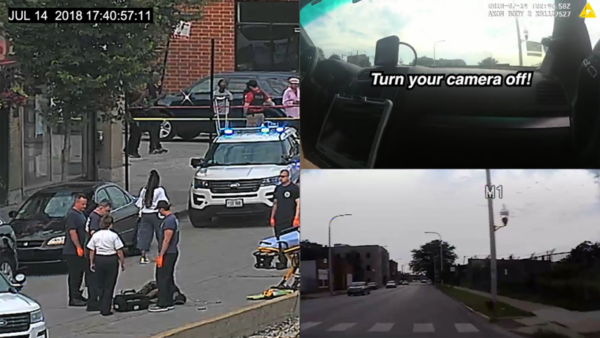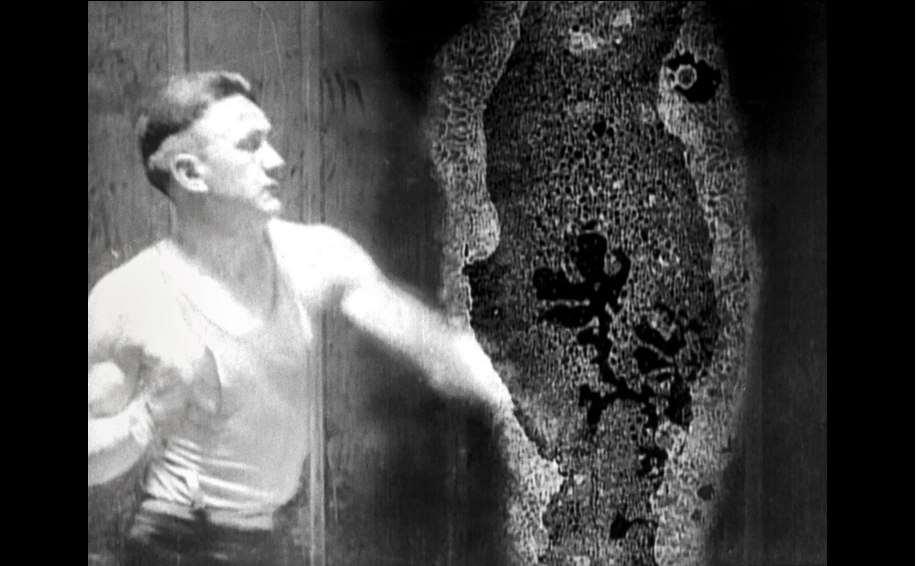Bill Morrison is known for his often-magical transformations of archival film in various states of decay into new works that speak to both past and present. Until the recent success of “Dawson City: Frozen Time” (2016), “Decasia” (2002), which was admitted to the National Film Registry in 2013, probably remained his best-known film. But Morrison’s fascination with the beauty and suggestiveness of archival decay in “Decasia,” emblemized by the canonical image of a man boxing with decay itself, was merely a premonition of the dozens of diverse shorts and features that followed.
Morrison has worked with archival film in so many inventive ways that we might imagine that he couldn’t surprise us. But his new short, “Incident” (2023, 29 minutes), is more than a surprise. It’s a breakthrough that offers the possibility of a new form of archival cine-education about aspects of American culture that have been “lost” until recently, buried within official public archives. “Incident” has the brevity, directness, and clarity of a Hemingway short story.
“Incident” begins in silence with a cosmic zoom into a map showing a location in south Chicago where “the incident” takes place. Then, a Police Observational Device camera (POD), located on the opposite side of 71st Street reveals, on a distant sidewalk, some activity involving police; then a man, Harith Augustus, running out into the street and falling to the ground, apparently having been shot:
Sound, recorded nearer to the event, is added just after this sequence, as a police officer yells, “Police shot! Or shots fired at police! Or….” Radio communications calling for back-up are heard, along with the voices of arriving police officers trying to determine what exactly has happened. As “Incident” continues, what we hear soon becomes more revelatory than what we see.
After a fade-out, the film returns to the scene, now “fifteen minutes earlier” and closer to the action. Silent footage recorded by a surveillance camera above the sidewalk allows us to watch the mundane activity on the sidewalk as superimposed visual texts provide background:
In the summer of 2018, the city of Chicago was anticipating the trial of police officer Jason Van Dyke, who had killed Laquan McDonald in 2014.
On October 14, 2014, officer Van Dyke had reported that McDonald had lunged at him with a knife, and that he had acted in self-defense by shooting him sixteen times, including nine times in his back.
Through the efforts of local investigative journalists, the dashboard camera recording the incident was finally released thirteen months later and PO Van Dyke was indicted on six counts of first-degree murder.
It would become a landmark case in police accountability
In 2016 Chicago adopted a new policy for the public release of audio and video recordings of incidents involving police officers.
Ultimately, this new policy made possible Morrison’s access to the video and audio records of the death of Harith Augustus at the hands of Chicago police officer Dillan Halley and of its immediate, chaotic aftermath. Except for the opening cosmic zoom, Morrison’s documentation relies entirely on imagery and sound recorded on official police surveillance gear and on what for Morrison was a new form of editing.
Imagery recorded by various surveillance cameras along the street reveals Augustus walking toward the area of the sidewalk where the deadly confrontation will soon take place — a superimposed text identifies him. He walks past five on-duty police officers, each also identified: Halley, Megan Fleming, Danny Tan, Quincy Jones, and Leon Coleman. At the time, Halley, Tan, and Coleman were Probationary Police Officers (PPOs) serving their first year on the force. As Augustus walks into the distance, a text indicates that “Ten minutes later PPO Dillan Halley would shoot Harith Augustus five times, and claim that he had acted in self-defense.” A fade-out follows, then “nine minutes later.”
Just before Augustus is seen in the distance, walking back toward the five officers, apparently returning to the barbershop where he works, two texts create further context for what is about to happen:
Illinois is one of the few states that require a permit, known as a Firearms Owner’s Identification (FOID) Card, in order to purchase and own a gun.
In 2013 it adopted the Firearms Concealed Carry Act, which further allows individuals with a valid license to carry a concealed handgun in public.
As Augustus passes Halley, Fleming, and Tan, they see, under his shirt, the outline of a handgun — and signal to officer Jones, further along the sidewalk. Jones asks Augustus to stop, apparently to show his FOID card, and while Augustus is in the process of taking the card from his wallet, he is grabbed from behind by Fleming. Augustus twists away, begins to run, and in a few seconds lies unconscious in the street, shot five times by Halley.
There are no further explanatory texts until the conclusion of the film. Morrison’s depiction of what follows combines available video and audio recorded by the POD, private closed circuit security cameras along the street, police dashboard cameras — and police body-worn cameras, which, unlike the other cameras, can record sound as well as imagery (during “Incident,” the dialogue recorded on police body cameras is confirmed by visual texts). The various cameras allow what police officers and bystanders do and say to be seen/heard from multiple angles.
To document the chaos of the events following the shooting, Morrison combines split-screen imagery and digital wipes, providing a complex panorama of what is occurring — though he is careful, throughout this extended moment, to keep Augustus’s body visible, even when the screen is providing multiple perspectives. The experience of watching the police during the immediate aftermath is candid and revealing. Ultimately, audiences must draw their own conclusions on the basis of what they see and hear.

Screen grab from “Incident”
No immediate serious effort seems made to determine if Augustus is alive, though one officer puts handcuffs on the immobile victim. And it is obvious that as soon as Augustus lies immobile, Halley and Fleming are already working to convince themselves that Halley shot in self-defense, despite the fact that Augustus’s gun remained in his holster.
Fleming and another officer soon escort Halley away from the crime scene for his protection, and Morrison intercuts between what is happening at the crime scene and the conversation in the fleeing car, where Fleming assures Halley that he saved her life — her “memory” of the incident seems to grow more melodramatic with each telling. At no point do any of the police that witnessed the event or who have arrived on the scene question Halley’s and Fleming’s assurances that Augustus shot at them.
The ethnic and gender diversity of the police officers involved in the incident, all of whom work together to protect Halley, foregrounds the current complexity of American race relations within a gun-saturated society (an issue raised in a somewhat different way by the January 7th police murder of Tyre Nichols in Memphis). What we see and hear in “Incident” demonstrates the degree to which the police can prioritize their professional status and security above their duty to protect and serve.
The comments of bystanders in the neighborhood during the final minutes of “Incident” add both information (that Augustus was a quiet barber who did no one any harm) and disinformation (that Augustus didn’t have a gun) to an increasingly complex situation that would result, that night, in protesters being beaten and four of them arrested, along with further protests.
To learn in one of the film’s final texts that, in the end, “PPO Dillan Halley who killed Harith Augustus, served a 2-day suspension for failing to activate his body worn camera in a timely manner” is simultaneously ironic and shocking — though, alas, hardly surprising. Megan Fleming was suspended for 60 days, for interfering with Officer Jones’s attempt to check Augustus’s FOID card, for discussing the incident with Halley, and for failing to activate her body worn camera.
When I asked Morrison in December, 2022, if he thought that “Incident” might un-resolve the official resolution of the killing, he said, “I don’t have illusions that this film will re-open the case. COPA [The Chicago Civilian Office of Police Accountability] concluded a full investigation nearly two years ago, and recommended disciplinary action for Halley in 2021. No further action was taken by the Chicago Police Department. I think of ‘Incident’ as a reflection of who we are as a society.”
“Incident” concludes with a final in-close version of Augustus being grabbed, then shot, and a final visual text (quoting a statement earlier by a woman responding to calls for back-up), “What we got and who are you?”
What we’ve got is a troubled system, and I’m one of many who is not sure how to transform it.
Morrison credits two organizations that were sources of information for “Incident”: Forensic Architecture and Invisible Institute.
Journalist Jamie Kalven was instrumental in bringing Augustus’s case (and Laquan McDonald’s) to light. The Intercept story about the event includes a short film that details the history of the release of the video and sound recordings and documents.
Working with Kalven, Forensic Architecture has produced a short film that analyzes the specifics of the killing itself.
“Incident” is currently on the festival circuit.
Scott MacDonald is author of “A Critical Cinema: Interviews with Independent Filmmakers” (5 volumes, California), “The Garden in the Machine” (California, 2001), and 14 other books, most recently “Avant-Doc: Intersections of Documentary and Avant-Garde Cinema” (Oxford, 2015) “The Sublimity of Document: Cinema as Diorama (Avant-Doc 2)” (Oxford, 2019); “William Greaves: Filmmaking as Mission” (Columbia, 2020) and “Comprehending Cinema (Avant-Doc 3)” (forthcoming). He teaches film history and programs F.I.L.M. at Hamilton College.

